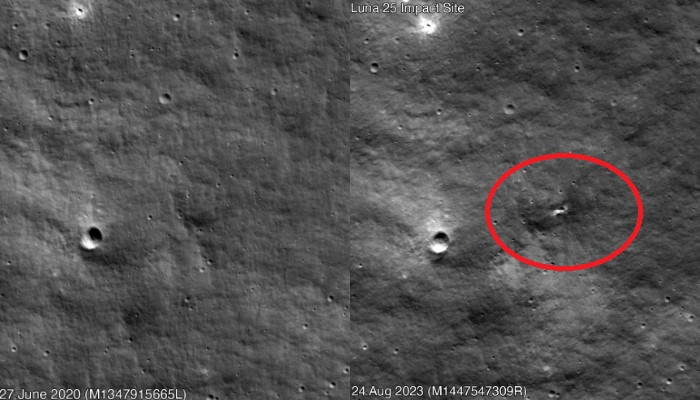NASA’s LRO Observes Crater Likely from Luna 25 Impact
 23438 Saturday, 02 September, 2023, 00:00 Roscosmos, Russia’s space agency, published an estimate of the impact point on Aug. 21. The LROC (short for LRO Camera) team and the LRO Mission Operations team were able to design and send commands to the LRO spacecraft on Aug. 22 to capture images of the site. The sequence began on Aug. 24 at 2:15 p.m. EDT (18:15 UTC) and was completed about four hours later, at 6:12 p.m. EDT (22:12 UTC). The LROC team compared images taken prior to the impact time and the sequence taken after and found a small new crater. LRO’s most recent "before" image of the area was captured in June 2022 (frame No. M1410024427R); thus, the crater formed sometime after that date. Since this new crater is close to the Luna 25 estimated impact point, the LRO team concludes it is likely to be from that mission, rather than a natural impactor. The new crater is about 10 meters in diameter and is located at 57.865 degrees south latitude and 61.360 degrees east longitude at an elevation of about minus 360 meters. The impact point was on the steep (greater than 20-degree grade) inner rim of Pontécoulant G crater, about 400 kilometers short of Luna 25’s intended landing point at 69.545 degrees south, 43.544 degrees east. LRO is managed by NASA's Goddard Space Flight Center in Greenbelt, Maryland, for the Science Mission Directorate at the agency’s Headquarters in Washington. Launched on June 18, 2009, LRO has collected a treasure trove of data with its seven powerful instruments, making an invaluable contribution to our knowledge about the Moon. Arizona State University manages and operates LROC.  |

Japan Unveils Human Washing Machine, Now You Can Get Washed Like Laundry (video)
954801.12.2025, 20:45
Chinese humanoid robot sets Guinness World Record with 106-km inter-city walk (video)
1001424.11.2025, 16:30
Musk։ Optimus will be able to eliminate poverty and provide everyone with a universal high income (video)
1166223.11.2025, 12:45
AGMI researchers expose the hidden role of female perpetrators in the Armenian Genocide (photo)
624813.11.2025, 21:15
LVM3-M5 mission successfully launches CMS-03 satellite (video)
877602.11.2025, 21:17
Google разработала квантовый алгоритм, работающий в 13 тыс. раз быстрее алгоритма суперкомпьютеров
854022.10.2025, 23:44
Apple introduces the powerful new iPad Pro with the M5 chip
935115.10.2025, 23:34
Apple debuts iPhone 17
947509.09.2025, 23:08
